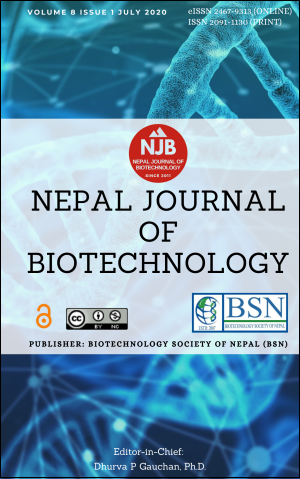Regeneration Technique of Bamboo Species through Nodal Segments: A Review
DOI:
https://doi.org/10.3126/njb.v8i1.30209Keywords:
Micropropagation, Nodal segments, Bamboo species, Plant Growth Regulators, Shooting, RootingAbstract
Micropropagation is an alternative technique to propagate at large scale plants to meet global plant demand. Various researchers have worked on the micropropagation technique to regenerate bamboo species by using nodal segments from years. Contamination, browning, necrosis, and acclimatization with physiological stress are the extreme problems of the micropropagation technique. But, many numbers of papers have been published on micropropagation of the bamboo species through nodal segments as explants. The proliferation of the bamboo shoots is dependent on the season of collection, size of explants, the position of explants, diversity of plants, concentration and combination of plant growth regulators, most adequate culture medium, environmental condition of the equipment, handling, and individual species. Bamboo is a monocarpic fast-growing, tall perennial grass and having the high potential to generate economic and social benefits. It helps to maintain land patterns and control soil erosion. The long life cycle of the bamboo produces a huge amount of seeds but unfortunately, mostly, they are non-viable. So, bamboos are propagated from vegetative by cutting and air layering. However, these methods are only for a small scale and they also tend to destroy large mother plant stocks and difficult to be transported. So, the in vitro propagation technique is useful to obtain large progenies from desired genotypes. Mostly, BAP and TDZ growth hormones are widely used for shoot multiplication and IBA, NAA and IAA are used for root initiation as per developed protocols in tissue culture for large scale production. This review intends to explore an overview of the recent literature reports to summarize the importance of micropropagation by using nodal segments of bamboo species and factors influencing it.
Downloads
Downloads
Published
How to Cite
Issue
Section
License
Copyright Notice:
The manuscript submitted to NJB must be an original contribution, not previously published and should not be under consideration for publication elsewhere. When the manuscript is accepted for publication, the authors agree to automatically transfer the copyright of the article to the publisher. It should grant permission to any third party, in advance and in perpetuity, the right to use, reproduce or disseminate your article, according to the NJB copyright and license agreement.
Authors transfer copyright to the publisher as part of a journal publishing agreement but have the rights to: Share their article for Personal Use, Internal Institutional Use and Scholarly Sharing purposes, with the NJB applies the Creative Commons Attribution-NonCommercial CC BY-NC license to all the works we publish after Jun 2020 (Before it was CC BY-NC-ND). Under this license, authors agree to make articles legally available for reuse, without permission or fees, for virtually any non-commercial purpose. Anyone may remix, adapt, and build upon your work non-commercially, and although their new works must also acknowledge you and be non-commercial, they don’t have to license their derivative works on the same terms. More details on CC BY-NC refer to its Licence Deed and Legal Code.






